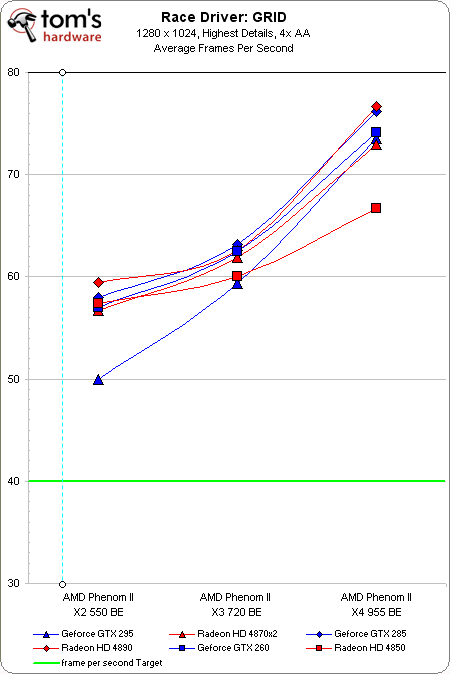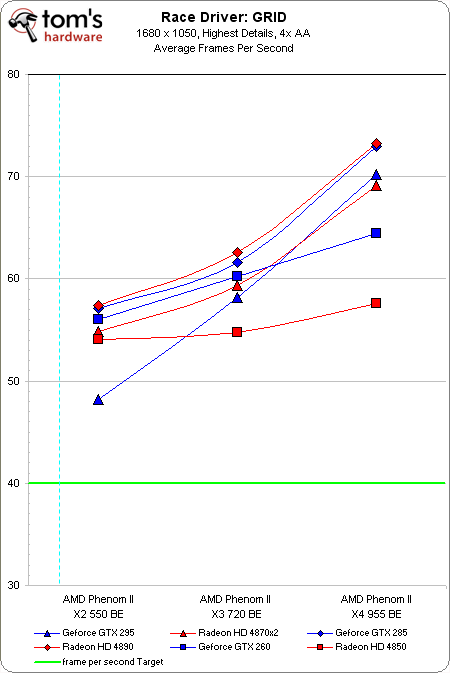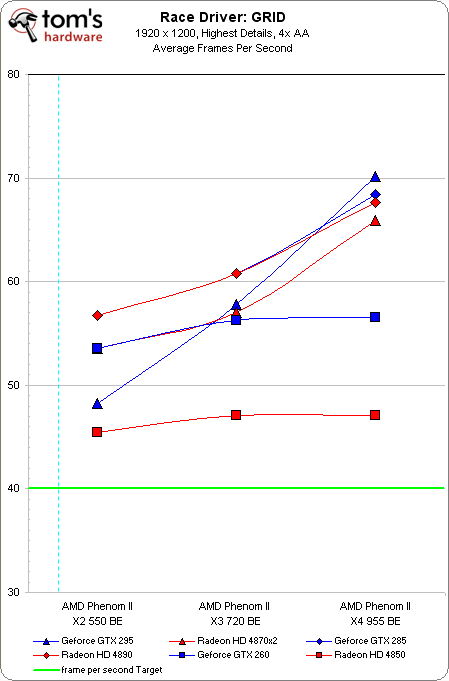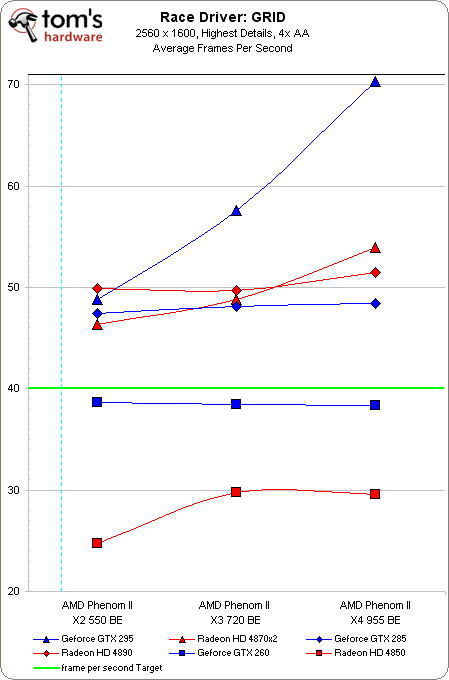Part 2: Building A Balanced Gaming PC
Benchmark Results: Race Driver GRID
Race Driver: GRID
In order to benchmark Race Driver: GRID, we use FRAPS to run a 45 second lap at the Detroit “Sports Car Circuit,” one of the more demanding tracks in the game. We also utilize the most demanding cockpit view and start/remain in the back of the pack, which should provide close to a worst-case scenario for performance. If you find this view difficult (or just enjoy looking at the shiny cars while you drive), you can typically gain performance by utilizing the swingman view.
Also note that some hardware configurations may suffer larger frame rate hits during night racing, resulting in somewhat lower performance than seen here. I happen to be a big fan of racing games and probably a little pickier than most people in terms of frame rates. Any time the performance drops below 40 FPS, it can be felt in this game. So, personally, I like to remain above 40 FPS. But your reaction time probably won't suffer unless frame rates drop to near 30 FPS, so we’ll settle for an average target of 40 FPS.
The upward slope and tight spacing at each step up in CPU progression signifies the processor limitation at these settings, and is a clear indication that GRID benefits from a quad-core CPU. The cheapest GPU/CPU combination does hit our target, although even the Radeon HD 4850 is held back when paired with less than a Phenom II X4 955 BE. The GeForce GTX 295 starts off behind, just as in Part 1. But it's held back from the 97 FPS it achieved with Intel's Core i7-920 by all of these AMD-based CPUs.
We see a similar picture at 1680x1050, with all 24 combinations reaching the target line. ATI's Radeon HD 4850 is starting to be taxed, and no longer delivers a significant boost when stepping up to a more expensive processor.
The GeForce GTX 260 balances well with Phenom II X3 720 BE, but the cheapest platform again still delivers an acceptable level of performance. The other four graphics cards are all held back from their full potential with anything shy of the three tested quad-core processors.
The GeForce GTX 260 and Radeon HD 4850 both fall below the green line at 2560x1600, leaving Phenom II X2 550 BE/Radeon HD 4890 as the cheapest solution in Part 2 to reach our target. The Radeon HD 4890 and GeForce GTX 285 balance out well with the dual-core Phenom II, while it takes the quad-core processor to keep up with the dual-GPU cards. The GeForce GTX 295/Phenom II X4 955 BE put up some impressive numbers, even slightly surpassing those generated in Part 1 on the LGA 1366-based Core i7 platform.
Get Tom's Hardware's best news and in-depth reviews, straight to your inbox.
Current page: Benchmark Results: Race Driver GRID
Prev Page Benchmark Results: Fallout 3 Next Page Benchmark Results: World In Conflict-
What effect does having a motherboard that unlocks the 4th core on the X2 and X3 have? In power consumption and overall performance? I'm not asking a redo of all the data, just asking for speculation by someone more knowledgeable, if I can get it.Reply
-
Readers, don't use this as your only source of info before buying a PC. The writer left out the Intel i5-750 (which has a price range around $189-209, and outperforms all of those CPUs EXCEPT the i7.) Not only that, but LGA1156 motherboards are typically cheaper than the LGA1336 mother boards. Sure, the i7 has hyper threading, and triple channel memory support, but you're gaming here, not running high end video and 3D programs that would actually make great use of hyper threading. The only benefit I can see, is if you have the extra cash to throw around and you plan on running the applications. I guess a second benefit would be expandability, since you won't be able to upgrade the 1156 chips to Intel's next line of processors, the i9. The i5 can really over clock like a beast with the right motherboard, too.Reply
The writer also left out a great GPU: the Radeon 4870 1GB. Single GPU card, almost perfect for anybody considering running today's games at 22" 1650x1080. Of course, you'd want the 4890 for bigger than that, but still, most of these cards (especially the nVidia ones) are not quite price matched with the performance. A good 4870 can run you $170, and a great 4890 can run you $199. The nVidia "equivalents" (GTX 275, 285, and 260) all run about $260+.
I'm not sure why these two great products were left out (i5 and 4870,) but if there is a good reason, disregard what I said, but honestly, I don't see the good this article is doing without at least including them. -
dragonsprayer The secret to building a balanced gaming by pc, by WarpedSystems.Reply
First, i have been building overclocked only gaming pc's since 2003 with zero failures and 3 year cpu warranty.
#1 cheap cpu - 3.0c northwood - research that far back! CPU = 920 or 750 clocked to 3.8ghz or up too 4.2ghz
#1.5 cpu cooling: in 2004 we used thermalright xp-90, while we still use the thermal right true, we perfer the noctua - research and use the best coolers.
rule 1 of air cooling: dual fans! seal the fans - see photos!
#2 raid, we run dual raid with short stroking - we have been short storking since 2004. Your hard drive arm should move as little as possible a 4 x 1000TB set is 1000GB of raid0 for the c drive. the remaing 3TB is raid 10.
ssd: we run raid5 on hard drive and single ssd as the c drive, the raid 5 is data drive/game drive. This could be a raid0 or raid10.
Video card, you put all your money in the video card! A $2000 computer can have a GTX 295 use the i5 750. A $3000 air cooled system will have 2 video cards.
Power supply = .6 x true max power. this is usually 500 watts to 600 watts of max power. A 750, 850 or 1000 is best. NEVER GO LESS THEN 40% OF AVERAGE! 60% rule allows for a video card upgrade.
Case ...fans, fans and more fans. Anetec 1200 can not be beat for air cooling. All cases are copies of the antec 900. There are many good cases but you want 1 120mm in, 120mm out rear and 1 120 mm blowing on the video card. or 2 80's or bigger
antec 1200 has 2 rear 120mm and 2 front - we pull one section on both the 900 and 1200 and hide wires in the lower cubbie. That means we move the bottom cage up 1 slot, we remove 1 3 slot cage.
check THG links: http://images.google.com/images?hl=en&rlz=1T4GGIH_enUS236US236&um=1&q=warpedsystems+thg&sa=N&start=0&ndsp=18
finally bios tuning - memory and bus speed are critical, too high is bad!!! Too high is bad! fsb 1600 or 400x4 has been the sweet spot for years. Whether your running a G0 6600 at 3.6GHz 1600fsb or QX9600 at 1l multiplier at 4.4ghz 1600fsb works! Above that you run into many many issues. At fsb 1600 ram timmigs are ddr2 = 2.0-2.1v 4-3-4-10, 4-4-4-12, etc with core 2 ddr3 at 1.91v you have 7-7-7 with the i7/i5 you run 1.64v at 8-8-8-20 or 8-7-8-20. you find true 100% stablity with the correct timings and fsb and you do not get odd phase bus speeds.
yes, you can tweek the system to 1800mhz but do the tests and you find in most cases you spent more money to get little performance gains and lost stability -- 97-100% stablity. 100% = zero crashes - never!
temps, video card temps are key. Manually set fan speeds to stay under 75c with 70c the best. Stock temps and high cards run 80-85c even with good systems. You can use really good cooling to reduce that with antec 1200 etc. A 120mm fan does not fit an i7 mobo - we use 92mm fans in the door and hot glue it.
Conclusion, overclock your cpu, remember the difference between an i7 920 and 975 may only be factory setting and both run the same speed! Buy the best video card, use the best cooling case and cpu cooler. If your not using a SSD ....RAID RAID RAID! RUN RAID! IT IS EASY!
good luck, you find you get alienware level performance just as i did in 2003 after a few weeks of bios tuning! -
1898 BlackDays:Reply
Please, if you want to criticise something make sure you've understood it (read in this case) thoroughly. Otherwise you'll look like an idiot.
Anyway, this series is made out of win!
Thank you. -
knightmike This article truly is revolutionary. I have been waiting for an article like this since I began building my own PCs ten years ago. This article coupled with your CPU and GPU hierarchy chart will go a long way towards eliminating CPU/GPU bottlenecks. This article truly is the first of its kind and I hope to see it at least twice a year if not four times a year. Thank you.Reply -
knightmike In your conclusion, you state that a $100 CPU does a far better job than a $100 GPU when it comes to maxing out a low resolution like 1280x1024. Can you elaborate?Reply -
amnotanoobie Hooray! Now this is a good reference on the forums when people ask for bottlenecksReply -
scrumworks How can this take weeks to plan? Perhaps if one works 15mins a day.Reply
Good to see vanilla HD4890 puts up a serious fight for GTX 285. Not that it gets any credit for that.
You should stop using Vista. It's dead already.



